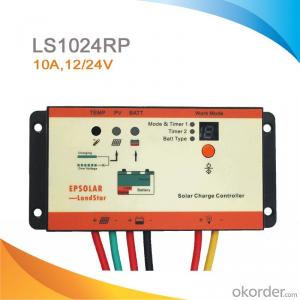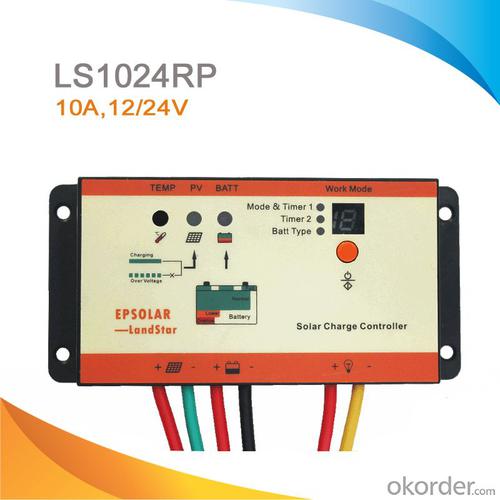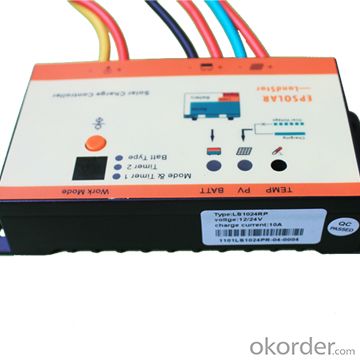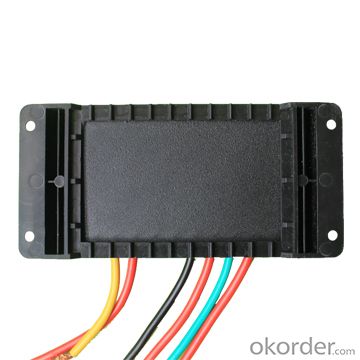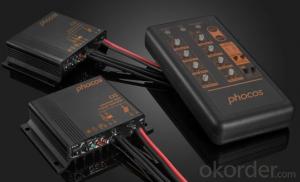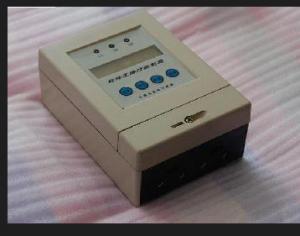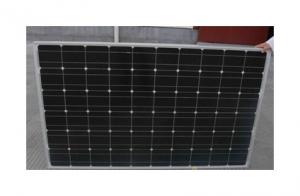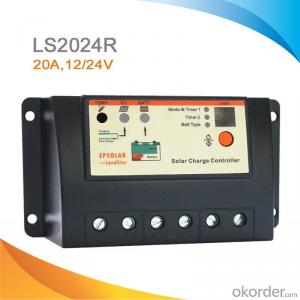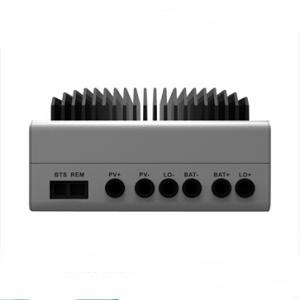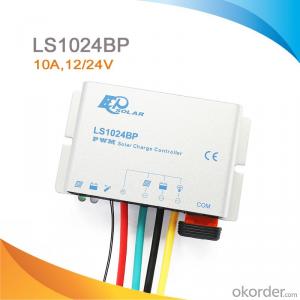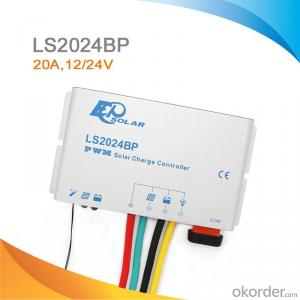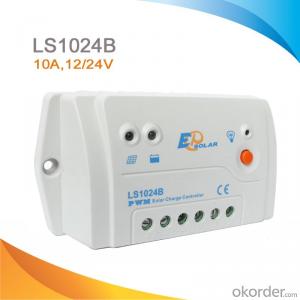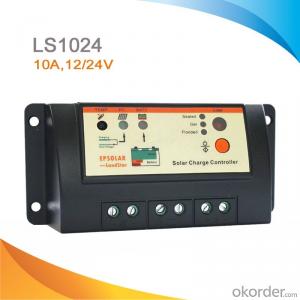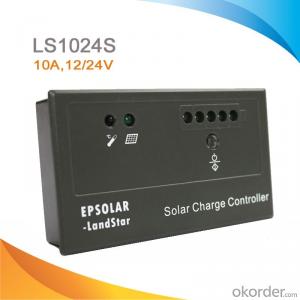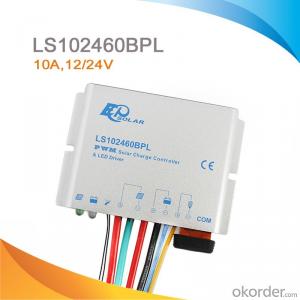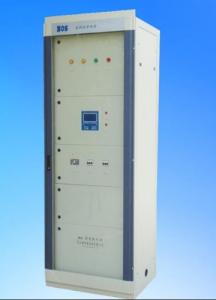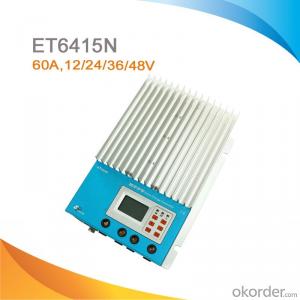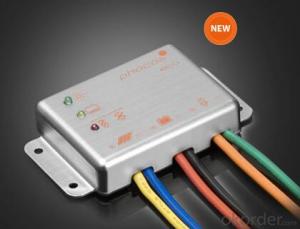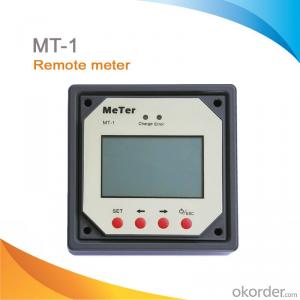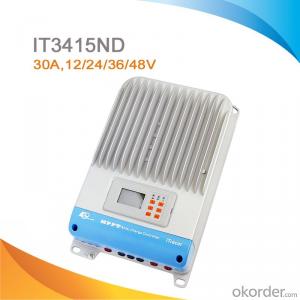Solar Controllers from South Korea Supplier - PWM Waterproof Solar Road Controller, 10A, 12/24V LS1024RP
- Loading Port:
- China main port
- Payment Terms:
- TT or LC
- Min Order Qty:
- -
- Supply Capability:
- -
OKorder Service Pledge
OKorder Financial Service
You Might Also Like
Features:
·Waterproof design
·High efficient Series PWM charging
·Gel, Sealed and Flooded battery type option
·Widely used, automatically recognize day/night
·Intelligent timer function with 1-15 hours option
·Use MOSFET as electronic switch
·Digital LED menu with simple setting and easy using
·Temperature compensation
·Reverse protection: any combination of solar module and battery
Electronic Protections:
·Overheating
·Over discharging
·Over charging
·Load overload
·Load short circuit
·PV short circuit
·PV reverse polarity
·Battery reverse polarity
Specification:
Electrical parameters | LS1024RP | LS2024RP |
Nominal System Voltage | 12 / 24VDC auto work | |
Rated Battery Current | 10A | 20A |
Max. Battery Voltage | 32V | |
Charge Circuit Voltage Drop | ≤0.26V | |
Discharge Circuit Voltage Drop | ≤0.15V | |
Self-consumption | ≤6mA | |
Overall dimension | 145 x 69 x 31mm | 145 x 85x 34mm |
Wire diameter | 4mm2 | 6mm2 |
Net weight | 0.3kg | 0.4kg |
Working temperature | -35℃ to +55℃ | |
Humidity | 10%-90% NC | |
Enclosure | IP66 | |
Battery Voltage Parameters (temperature at 25℃) | |||
Battery charging setting | Gel | Sealed | Flooded |
Equalize Charging Voltage | —— | 14.6V;x2/24V | 14.8V;x2/24V |
Boost Charging Voltage | 14.2V;x2/24V | 14.4V;x2/24V | 14.6V;x2/24V |
Float Charging Voltage | 13.8V;x2/24V | 13.8V;x2/24V | 13.8V;x2/24V |
Low Voltage Reconnect Voltage | 12.6V;x2/24V | 12.6V;x2/24V | 12.6V;x2/24V |
Low Voltage Disconnect Voltage | 11.1V;x2/24V | 11.1V;x2/24V | 11.1V;x2/24V |
Equalize Duration | —— | 2 hours | 2 hours |
Boost Duration | 2 hours | 2 hours | 2 hours |
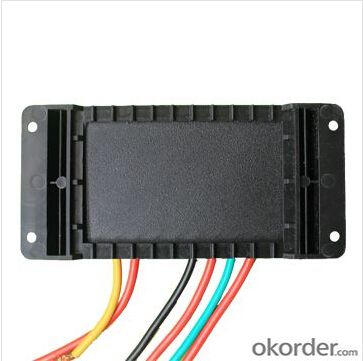
FAQ:
Q1. What is the voltage?
A1. Our 45/60A solar charge controller is 12/24/36/48V auto work.
Q2. What is the difference between MPPT&PWM?
A2. MPPT has higher efficiency, it can track the max power point and won't waste energy.
Q3. What is the efficiency of the MPPT controller?
A3. MPPT>99%, peak conversion efficiency>98%.
Q4. What is the waranty of product?
A4. 12 months.
Q5. What protection does your MPPT controller have?
A5. PV array short circuit, PV reverse polarity, Battery reverse polarity, Over charging, Output short circuit.
- Q: How does a solar controller handle power fluctuations in the system?
- A solar controller handles power fluctuations in the system by constantly monitoring the voltage and current levels of the solar panels. When there is an increase in power, the controller regulates the flow and redirects any excess energy to the battery bank for storage. Similarly, if there is a decrease in power, the controller compensates by drawing additional power from the battery bank to maintain a steady supply. This control mechanism ensures a stable and consistent power output from the solar system, regardless of fluctuations in sunlight or energy demand.
- Q: Can a solar controller be used in a solar-powered RV system?
- Yes, a solar controller can be used in a solar-powered RV system. A solar controller is an essential component in a solar-powered system as it regulates and manages the energy flow from the solar panels to the batteries. It ensures that the batteries are charged efficiently and protects them from overcharging or damage. Therefore, using a solar controller in an RV system helps optimize the performance and lifespan of the batteries, making it a crucial component in a solar-powered RV setup.
- Q: What is the maximum voltage drop allowed between the solar panels and the batteries?
- The maximum voltage drop allowed between the solar panels and the batteries depends on the specific system and its components. Generally, it is recommended to keep the voltage drop as low as possible, ideally below 3% to ensure efficient power transfer and minimize energy loss. However, it is best to consult the manufacturer's specifications and guidelines for the specific solar panels and batteries being used to determine the maximum allowable voltage drop.
- Q: Can a solar controller work with different types of solar panels?
- Yes, a solar controller can work with different types of solar panels as long as the voltage and current ratings of the panels are within the specifications and capabilities of the controller.
- Q: Can a solar controller be used with solar panel carports?
- Yes, a solar controller can be used with solar panel carports. A solar controller helps regulate the voltage and current from the solar panels to ensure optimal charging of the batteries or grid connection. It can also protect the system from overcharging or discharging. Therefore, using a solar controller with solar panel carports can enhance the efficiency and performance of the solar power system.
- Q: Can a solar controller be used with a solar panel cleaning system?
- Yes, a solar controller can be used with a solar panel cleaning system. A solar controller is responsible for regulating the flow of electricity from the solar panels to the batteries or grid. It ensures that the solar panels operate at their maximum efficiency and protects the batteries from overcharging. Since a solar panel cleaning system is typically connected to the solar panels, a solar controller can be used to monitor and control the power flow during the cleaning process, ensuring the system operates safely and effectively.
- Q: What is the role of a solar controller in maintaining battery health?
- The role of a solar controller in maintaining battery health is to regulate the charging process of the battery connected to the solar panel system. It ensures that the battery is charged at the optimal voltage and current levels, preventing overcharging or undercharging, which can both be damaging to the battery's health. By maintaining the battery within its safe operating range, the solar controller helps prolong its lifespan and ensures its efficiency and reliability over time.
- Q: What is the maximum discharge efficiency of a solar controller?
- The maximum discharge efficiency of a solar controller refers to the percentage of energy that can be extracted from the battery bank by the controller. This efficiency can vary depending on the specific model and technology used, but generally, high-quality solar controllers can achieve discharge efficiencies of around 95% or higher.
- Q: How do you troubleshoot common issues with a solar controller?
- To troubleshoot common issues with a solar controller, you should first check the connections to ensure they are secure and free from corrosion. Next, verify that the solar panels are receiving adequate sunlight and that they are connected properly to the controller. Additionally, examine the battery connections and ensure they are clean and tightly connected. It's crucial to inspect the controller's display for any error codes or abnormal readings, which may indicate a malfunction. Finally, consult the manufacturer's manual or online resources for specific troubleshooting steps and contact technical support if further assistance is needed.
- Q: What are the advantages and disadvantages of an MPPT solar controller?
- Advantages of an MPPT (Maximum Power Point Tracking) solar controller: 1. Increased Efficiency: MPPT controllers can improve the overall efficiency of a solar system by up to 30%. They track the maximum power point of the solar panels and adjust the voltage and current to ensure that the panels are operating at their optimal efficiency, even under varying weather conditions. 2. Better Performance in Low Light Conditions: MPPT controllers are designed to extract maximum power from the solar panels, even in low light conditions. This means that they can generate electricity even when the sunlight is not at its peak, making them ideal for areas with frequent cloud cover or shading. 3. Compatibility with Different Solar Panel Configurations: MPPT controllers can be used with a wide range of solar panel configurations, including both high and low voltage panels. This makes them highly versatile and suitable for various system setups. 4. Ability to Charge Different Battery Types: MPPT controllers are capable of charging different types of batteries, such as lead-acid, lithium-ion, or gel batteries. They have built-in algorithms that optimize the charging process for each specific battery type, ensuring maximum battery life and performance. Disadvantages of an MPPT solar controller: 1. Higher Cost: MPPT controllers are generally more expensive compared to PWM (Pulse Width Modulation) controllers, which are a simpler and cheaper alternative. The additional features and advanced technology of MPPT controllers contribute to their higher price point. 2. Complex Installation and Setup: MPPT controllers require more complex installation and setup compared to PWM controllers. They often require additional wiring and configurations to connect the solar panels, batteries, and load. This may require professional assistance or a good understanding of electrical systems. 3. Increased Maintenance Requirements: MPPT controllers are more sophisticated devices, and as such, they may require more maintenance compared to PWM controllers. Regular monitoring and occasional firmware updates may be necessary to ensure optimal performance. 4. Potential for Overheating: MPPT controllers can generate more heat during operation due to their advanced circuitry. This heat needs to be dissipated effectively to prevent damage to the controller or reduce its lifespan. Adequate ventilation and proper installation are essential to avoid overheating issues. Overall, the advantages of an MPPT solar controller, such as increased efficiency, better performance in low light conditions, compatibility with different panel configurations, and the ability to charge various battery types, often outweigh the disadvantages. However, the higher cost, complex installation, increased maintenance requirements, and potential for overheating should be considered when making a decision.
Send your message to us
Solar Controllers from South Korea Supplier - PWM Waterproof Solar Road Controller, 10A, 12/24V LS1024RP
- Loading Port:
- China main port
- Payment Terms:
- TT or LC
- Min Order Qty:
- -
- Supply Capability:
- -
OKorder Service Pledge
OKorder Financial Service
Similar products
Hot products
Hot Searches
Related keywords
